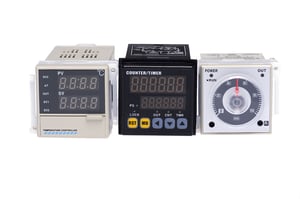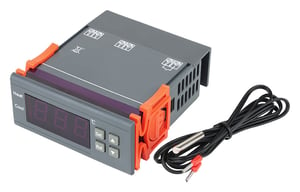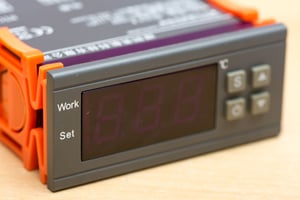 What is a temperature controller?
What is a temperature controller?
A temperature controller is a device that is used to maintain a preset temperature for a heater or other devices. In everyday life, common temperature controllers are air-conditioners, space-heaters, refrigerators, and water-heaters. However, when it comes to the industrial industry, temperature controllers can be attached to equipment and aid that equipment in maintaining a desired temperature.
Furnaces, ceramic kilns, and boilers use temperature controllers in the heat treat/oven industries. Packaging industries attach them to seal bars, glue applicators, hot melt functions, shrink wrap tunnels, or label applications. Laboratory and test equipment, autoclaves, incubators, refrigeration equipment, and crystallization growing chambers in the health care industry all have temperature controllers. The food & beverage industry use temperature controllers for brewing, blending, sterilization, and cooking and baking.
 All temperature controllers operate in a similar fashion. A set point or the desired temperature will first be programmed into the device. Through a sensor signal, that set point will be continuously tracked. If the sensor signal tracks any deviation of the temperature, it will send an output signal allowing for the device to correct the value so that the set point is maintained. Three of the most common temperature controllers are on/off, proportional, and PID.
All temperature controllers operate in a similar fashion. A set point or the desired temperature will first be programmed into the device. Through a sensor signal, that set point will be continuously tracked. If the sensor signal tracks any deviation of the temperature, it will send an output signal allowing for the device to correct the value so that the set point is maintained. Three of the most common temperature controllers are on/off, proportional, and PID.
On/off is known to be the most basic form of temperature controllers. Examples of this are found in HVAC units. For heating control an on/off controller is operated through a set point or the desired temperature being programmed into the unit. If that temperature dips below the set point the system will apply heat to allow it to regain the desired temperature. Once the desired temperature is regained, the unit will shut off. However, if that temperature dips back below the desired temperature the heater will kick back on to regain the set point. It can operate in a similar fashion when it comes to cooling control. A set point will once again be made, and if it rises above the set point cool air will kick in and regain the desired temperature. Once the desired temperature is reached the unit will shut off. When it comes to on/off controllers there is no in between temperature, it is either on to regain the desired temperature or off when that desired temperature is reached and stable.
 On/off controllers are in a constant state of being either on or off to maintain the temperature or regain the desired temperature. Proportional temperature controllers were designed with the thought to eliminate that constant cycle. A proportional controller is never just on or off. Instead it is tuned to match the characteristics of the process, which can be difficult in some cases. This has the affect of allowing the heater or cooler to not overshoot the desired temperature, but to maintain it. However, having to adjust and tune the characteristics can be difficult. But once tuned correctly, a much more stable control will come about compared to the on/off controller.
On/off controllers are in a constant state of being either on or off to maintain the temperature or regain the desired temperature. Proportional temperature controllers were designed with the thought to eliminate that constant cycle. A proportional controller is never just on or off. Instead it is tuned to match the characteristics of the process, which can be difficult in some cases. This has the affect of allowing the heater or cooler to not overshoot the desired temperature, but to maintain it. However, having to adjust and tune the characteristics can be difficult. But once tuned correctly, a much more stable control will come about compared to the on/off controller.
Lastly, the PID temperature controller is one that took the idea of a proportional controller and expanded upon it. P standing for proportional, I standing for integral, and D standing for derivative. Proportional compensates for the variance between the setpoint and the current process temperature. Integral is the previous variance from the setpoint. Derivative is the predicted future of variance based on previous and current variance. These three values must be individually adjusted or ‘tuned’ using trial and error. After trial and error is successful, the PID system will provide the most accurate and stable control of all three. If the system is known for consistent temperature change the PID will be the best option, due to the ability to automatically tune themselves with low supervision.
A temperature controller is very self explanatory. Temperature controllers can come in forms that are useful in everyday life or they can come in forms that are utilized in an industrial environment. Whether it’s the temperature in a home or the furnace in a metal working plant, temperature controllers will create benefits.
For information about how Radwell can provide you with industrial automation solutions for your operation


